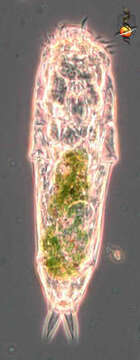portrait

Description:
This is a bdelloid rotifer (metazoa), body with an exoskeleton usually in elements that will telescope, posterior end often with two podites (like gastrotrichs to which they are probably related). Very common in aquatic habitats especially those which are prone to dry out - like moss, soils and the contents of pitcher plants. They can resist drying because they can form cysts, but some species are known to be cryptobiotic - that is they can dry out completely, and the organisms can come back to life when wetted. Usually eat bacteria or suspended protists, using the cilia of the corona at the front end of the body to sweep particles into the front of the body where an armoured mastax or jawed pharynx helps to grind the food. Rotifers are common members of the microbial communities of many aquatic ecosystems. Although they are multiceullar animals, they may be only be 100 microns long, and so overlap in size with ciliates. They can be confused with ciliates because they use cilia to capture their food. However, they can be distinguished because they have an exoskeleton, usually two posterior toes, and a tough pharyngeal region just behind the head. Hendrik Seegers says this is probably a non-contracted Lecane because of the toes which appear to bear claws and the more or less regular lower half of the body, below the constriction. Phase contrast.
Included On The Following Pages:
- Life (creatures)
- Cellular (cellular organisms)
- Eukaryota (eukaryotes)
- Opisthokonta (opisthokonts)
- Metazoa (Animal)
- Bilateria
- Protostomia (protostomes)
- Spiralia (spiralians)
- Gnathifera
- Syndermata
- Rotifera (rotifers)
- Ploima
- Lecanidae
- Eurotatoria
- Lecane
This image is not featured in any collections.
Source Information
- license
- cc-by-nc
- author
- David Patterson, Linda Amaral Zettler and Virginia Edgcomb
- provider
- micro*scope
- original
- original media file
- visit source
- partner site
- micro*scope
- ID


